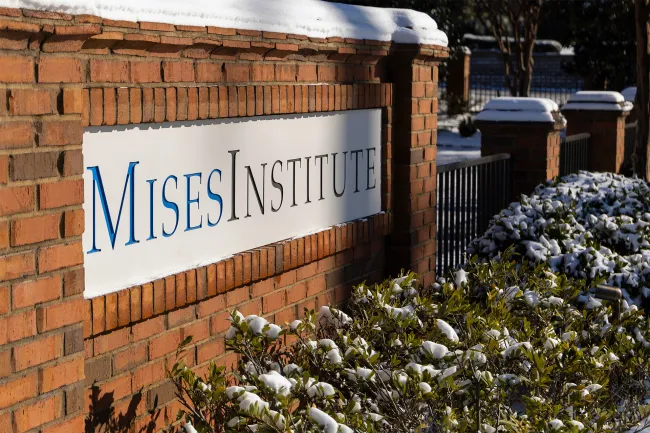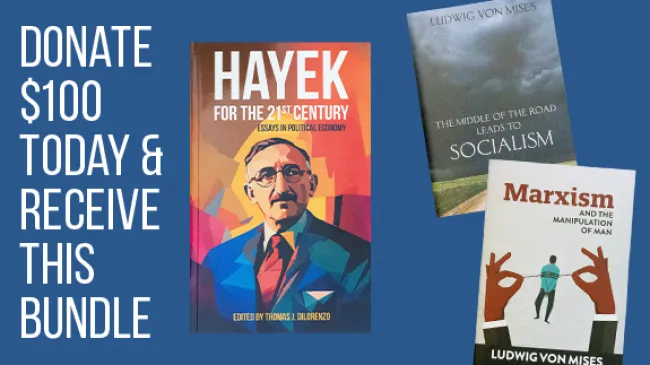In fundamental opposition to the principle of an organic economic order—where the individual actions of millions of free people, operating within frameworks of private property rights and rule of law, spontaneously coordinate to create wealth—Islamic Republic of Iran has constructed something entirely different: a deliberately engineered system of institutional predation. This is not a failing economy requiring technical adjustments, nor is it simply a case of corruption within an otherwise functional system. Rather, Iran’s economic structure is a purposefully designed extraction mechanism, a kleptocratic organism that ensures its survival by systematically destroying the very institutional foundations necessary for productive activity.
This parasitic entity feeds on the epistemological vacuum created when authentic price signals disappear. Without genuine market prices—those informational capsules encapsulating the dispersed knowledge, preferences, and judgments of millions of individuals—rational economic calculation becomes impossible. Resource allocation cannot be guided by economic logic; instead, it becomes the domain of political power, arbitrary decision-making, and systematic predation. What we witness in Iran is not market failure, but the complete and deliberate absence of free markets, replaced by centralized command structures optimized for extraction rather than production.
The Anatomy of Organized Theft
This engineered disorder operates through an intertwined network of military-security cartels and quasi-religious foundations that appear separate but function as organs of a single predatory body. The Islamic Revolutionary Guard Corps (IRGC), controlling an estimated 30-50 percent of Iran’s formal and informal economy, has metastasized from its original military role into the country’s largest monopolistic conglomerate. Its engineering arm, Khatam al-Anbiya Construction Headquarters, exemplifies the mechanics of institutional plunder. Through the systematic elimination of competitive processes via no-bid contracts, it has captured infrastructure projects worth hundreds of billions of dollars—including the $2 billion South Pars gas field development, Tehran Metro expansions exceeding $1.5 billion, the Bam earthquake reconstruction, highway networks spanning thousands of kilometers, and numerous dam projects.
The selection criteria for these massive capital deployments have nothing to do with economic efficiency or social return. They are determined by strategic positioning and institutional financial requirements, representing textbook malinvestment on a national scale. These are not market entrepreneurs confronting uncertainty to serve society, but political entrepreneurs extracting profits from lobbying, monopoly, and state coercion—a negative-sum game in which wealth is not merely redistributed but annihilated. The IRGC’s empire extends far beyond construction into telecommunications monopolies, port operations facilitating both legitimate trade and a sophisticated smuggling network, automotive sector dominance, and energy sector control. This smuggling network, estimated to move $12-25 billion in illegal imports annually, is not a peripheral crime but an integrated component of state economic policy, flooding markets with untaxed goods and waging systematic economic warfare against Iran’s legitimate productive sector.
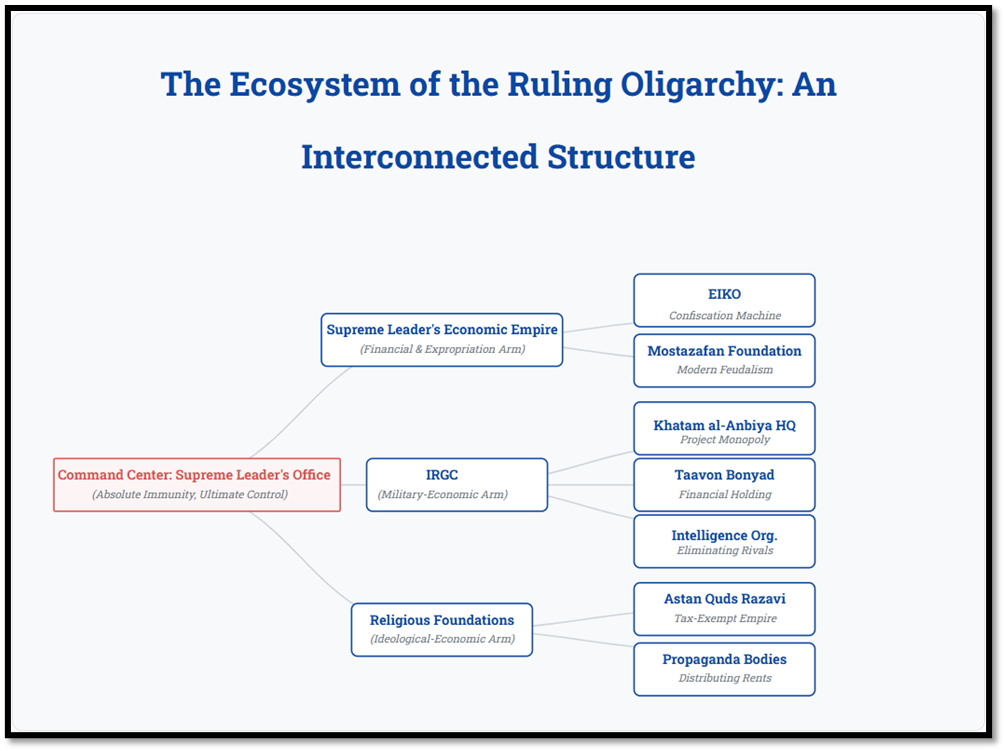
Parallel to this military-commercial dominance operate the Supreme Leader’s vast economic holdings, principally through two massive entities: the Execution of Imam Khomeini’s Order (EIKO) and the Mostazafan Foundation. EIKO, with assets estimated between $95-200 billion, has evolved into Iran’s largest holding company, encompassing telecommunications, thousands of properties, banking operations like Sina Bank, and substantial holdings in oil and gas. The Mostazafan Foundation, with assets worth $45-70 billion, operates over 500 companies across diverse sectors. These tax-exempt foundations enjoy absolute power, systematically driving any independent entrepreneur out of the market. The state’s “privatization” program under Article 44 was, in reality, the largest organized transfer of wealth in Iran’s modern history. Between 2005 and 2013, over $100 billion in state assets were transferred, with 60-80% going to these IRGC and foundation-linked entities, thereby formalizing their predatory control over the entire economy.
The Monetary Mechanism of Confiscation
The metabolism fueling this predatory organism operates through a devastating monetary mechanism. Iran’s Central Bank has transformed from a monetary authority into a perpetual money-printing apparatus, servicing state deficits and covering the losses of bankrupt, politically connected banks. The consequences have been deliberate and devastating. After averaging 25-30 percent in the 1990s and spiking to 40-45 percent in 2012-2013, inflation rates have been sustained at 40-50 percent from 2021-2024. As a result, the Iranian rial has lost approximately 99.9 percent of its value against the dollar over three decades—collapsing from roughly 70 rials per dollar in 1979 to over 1,000,000 by late 2025.
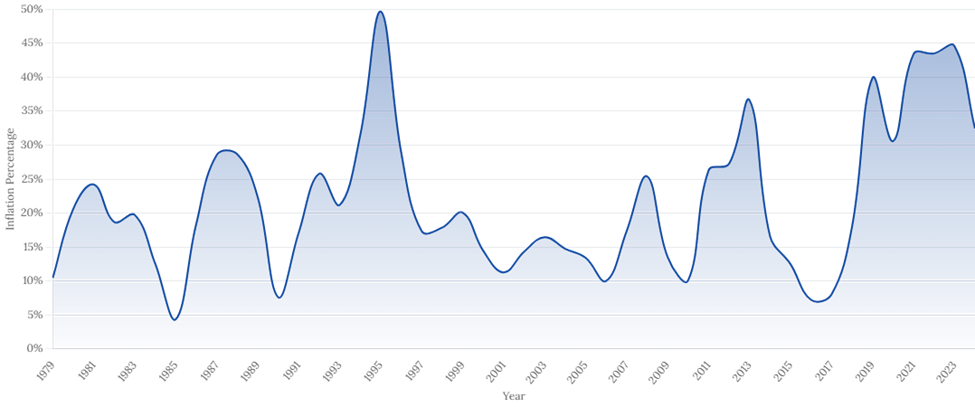
This inflation is a policy choice that functions as a tool of mass confiscation. Following the precise pattern described by the Cantillon effect, newly created money enters the economy unevenly. It first flows to government contractors, state-connected banks, and privileged businesses, who purchase goods and assets at pre-inflation prices. By the time this money circulates to wage earners, pensioners, and small savers, prices have already risen, leaving them with severely diminished purchasing power. This is not a theoretical abstraction but a lived reality: middle-class savings have been effectively confiscated, real wages have declined by 50-70% since 2011, and retirement funds have been rendered worthless. It is legal plunder on a national scale.
Alongside this operates Iran’s multi-tiered foreign exchange system, where politically connected entities receive foreign currency at artificially low official rates for “essential imports,” then sell goods at prices based on the free market rate. The gap between these rates creates rents estimated at $15-30 billion annually. Scandals, such as the ‘2023 Iranian tea smuggling scandal’ where $3.37 billion in subsidized foreign exchange was diverted, reveal a system designed for illicit profiteering at the expense of the productive economy.
Banking and Property Rights Demolished
Iran’s banking system is a critical component of the plunder machine. Rather than intermediating savings to productive investment, Iranian banks have become vehicles for politically directed credit and wealth extraction. Non-performing loan ratios tell the story: while official figures claim 15-20 percent, independent estimates suggest 30-40 percent of all loans are unrecoverable—a figure signaling a catastrophic systemic crisis. Banks channel capital to unviable IRGC projects and keep zombie state-owned enterprises alive through continuous credit injections, systematically destroying the nation’s capital base. This ecosystem also allowed for the explosion of unlicensed credit institutions that operated as pyramid schemes, collapsing and wiping out the savings of millions.
Furthermore, Iran’s constitutional and legal structure actively undermines property rights. Article 49 empowers the state to confiscate wealth obtained through vaguely defined crimes like “corruption,” a weapon wielded for mass expropriation with minimal due process. EIKO’s growth into a conglomerate was fueled by such ongoing confiscations through Revolutionary Courts and forced sales. This systematic violation of property rights creates predictable consequences: entrepreneurs optimize for short-term extraction, capital flight accelerates to an estimated $20-40 billion annually, and long-term productive investment is paralyzed.
The Human Catastrophe and The Impossibility of Reform
The consequences of this system are a profound human catastrophe. Iran suffers one of the world’s highest brain drain rates, with an estimated 150,000-180,000 educated individuals—engineers, doctors, scientists, and entrepreneurs—leaving annually. They flee a system where success depends not on competence but on connections. Meanwhile, while official statistics claim poverty rates of 25-30 percent, more realistic estimates suggest absolute poverty affects over half of the population. The social fabric is tearing as trust in institutions, currency, and fellow citizens has collapsed. Young Iranians increasingly cannot afford to marry or have children, with birth rates collapsing below replacement level.
The Iranian regime consistently attributes this economic catastrophe to external sanctions. While sanctions impose costs, they are fundamentally a scapegoat obscuring a deeper systemic rot. The economy’s structural problems predated heavy sanctions and persisted even during periods of relief, such as the JCPOA era from 2015-2018. Paradoxically, sanctions have strengthened the kleptocratic structure by empowering IRGC smuggling networks and providing the regime with an external enemy to blame for its self-inflicted failures.
To speak of “reforming” this system is to fundamentally misunderstand its nature. This is not a functional economy with bad policies; the structure is not diseased—it is the disease itself. Systematic violation of property rights is how the system functions. Monopolization is its organizing principle. Any genuine reform would dismantle the wealth extraction mechanisms that sustain the ruling elite, making it an existential threat to their power. Western policymakers repeatedly fail to grasp that the regime desires a controllable extraction mechanism, not a functional economy.
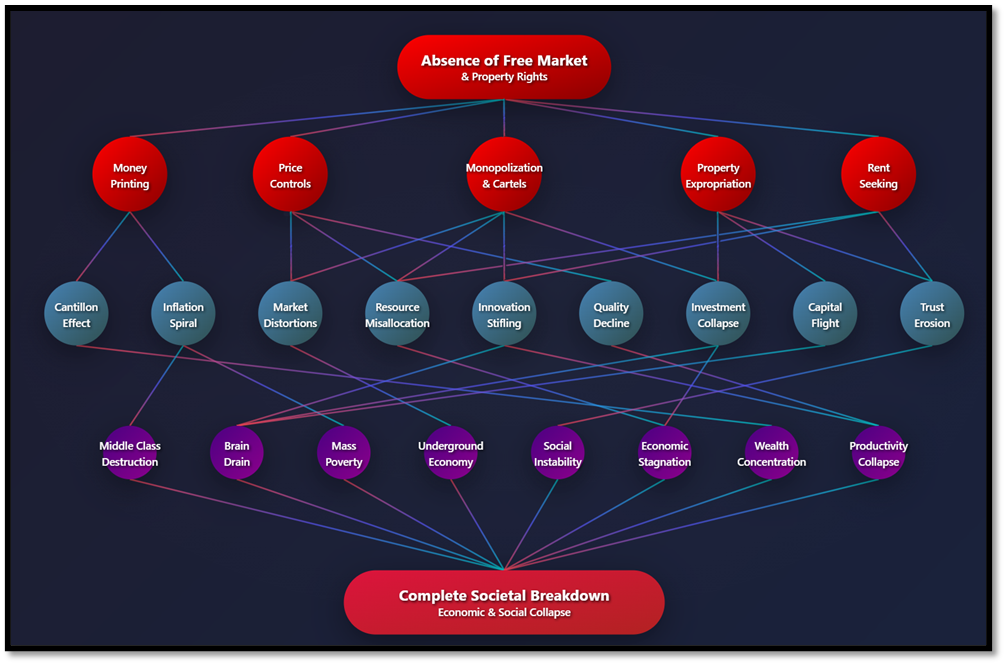
What has been described is a civilization-level crime—the systematic destruction of a society’s productive capacity to enrich a predatory elite. The tragedy extends beyond material wealth to generational trauma and cultural devastation. The Iranian people possess immense human capital and an entrepreneurial spirit. Under institutions that respect property rights and permit economic freedom, Iran could be one of the world’s most dynamic economies. Instead, they are trapped. This is a description of reality: Iran’s economic system is not failing to achieve prosperity—it is succeeding perfectly at its actual purpose, which is systematic extraction and control. The only solution is the complete dismantling of this machine of plunder and the construction of institutional foundations based on the absolute rule of law and unshakeable economic freedom.

